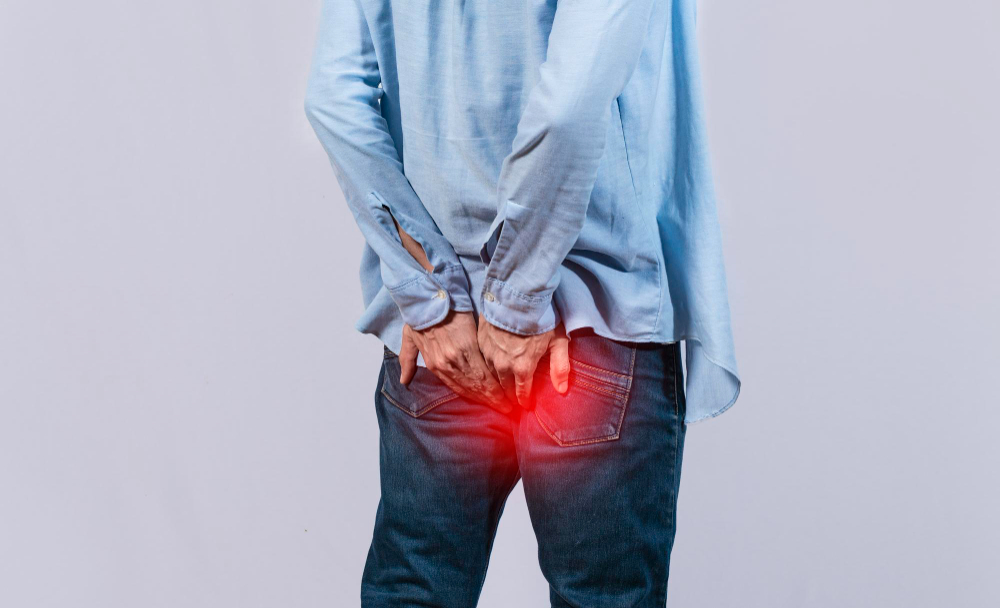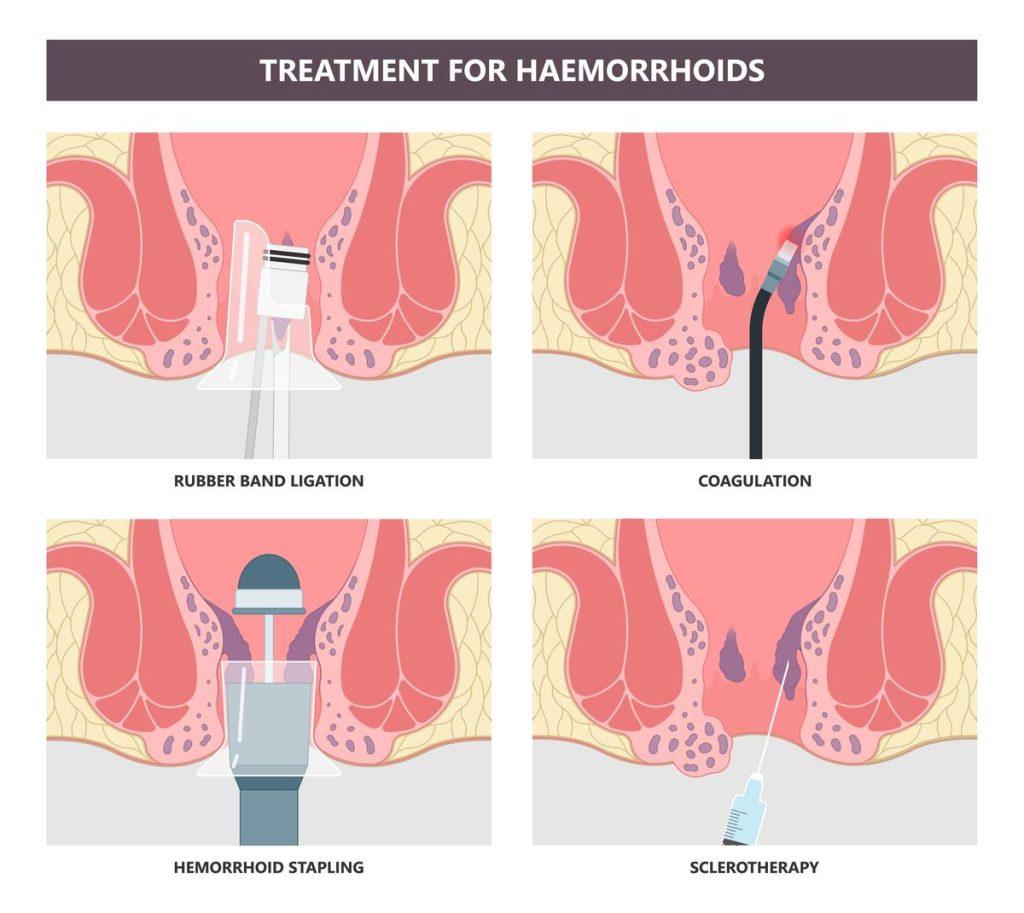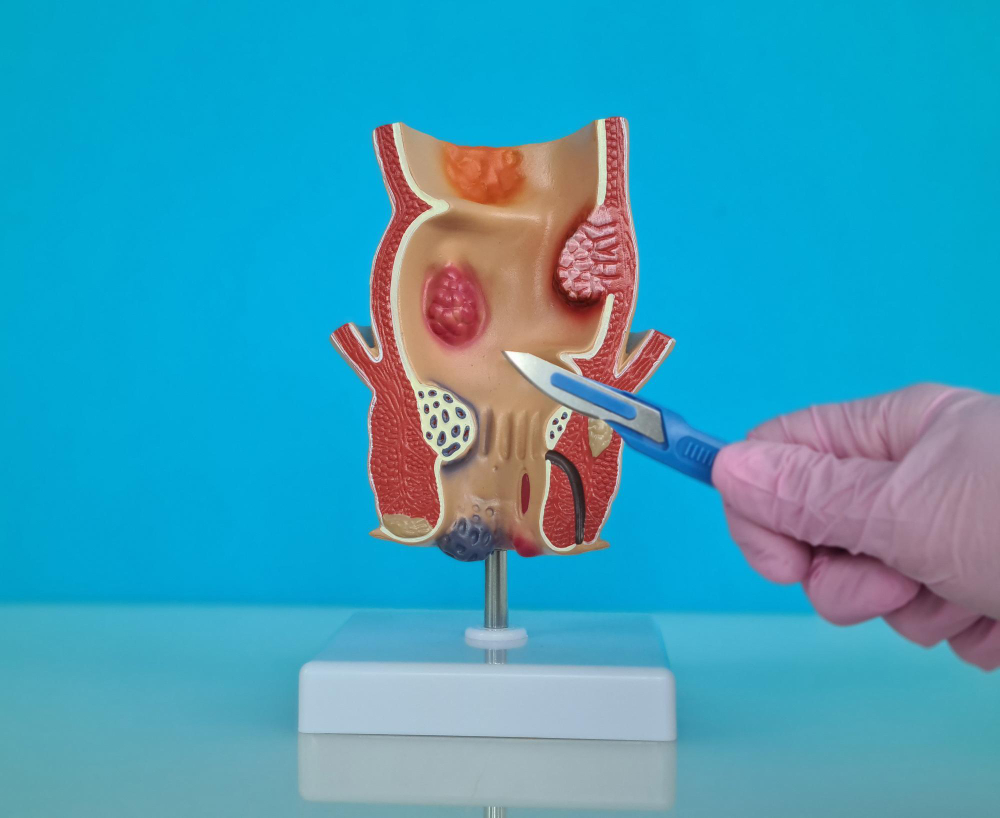Hemorrhoid Surgery
Surgeons perform a procedure known as hemorrhoid surgery to eliminate enlarged blood vessels situated inside or surrounding the anus and rectum, which medical professionals commonly call hemorrhoids.

Types of hemorrhoid surgery
Hemorrhoid surgeries can be categorized into two types: simpler procedures that are done on an outpatient basis without anesthesia and are less invasive, and more complex surgeries that require hospitalization.
Your doctor will decide if surgery is necessary and which procedure is most suitable for you based on how severe your symptoms are and if any complications are present.
Hemorrhoids are categorized based on their seriousness and graded accordingly in the following manner:
- Grade 1: no prolapse
- Grade 2: self-resolving prolapse
- Grade 3 refers to a condition called prolapse, which requires individuals to manually push back the affected area.
- Grade 4: a condition where a prolapse occurs and cannot be manually pushed back, leading to discomfort or agony.
What is a haemorrhoidectomy?
A haemorrhoidectomy is a surgical procedure that is performed to remove severe haemorrhoids, also referred to as piles. Typically, it is an outpatient procedure done while the patient is under general anaesthesia. The operation is commonly performed and considered safe, although post-surgery recovery can be uncomfortable and may take several weeks.
Why It Is Done
A hemorrhoidectomy may be performed if you are experiencing:
- Very large internal hemorrhoids.
- Nonsurgical treatment may not completely alleviate symptoms in cases of internal hemorrhoids that persist.
- External hemorrhoids that are of significant size, resulting in a considerable amount of discomfort and difficulty in maintaining cleanliness in the anal region.
- Both internal and external hemorrhoids.
- If previous methods, like rubber band ligation, have been ineffective in treating hemorrhoids.
Diagnosing and classifying hemorrhoids
Hemorrhoids occur when the bundle of blood vessels, muscle fibers, and connective tissue protrude below the dentate line in the anal canal. A common symptom is painless bleeding from the rectum.
The diagnosis of hemorrhoids is determined through a patient’s medical history and physical examination, rather than using laboratory tests or imaging studies. The main symptom experienced is painless bleeding from the rectum during bowel movements. This bleeding is typically noticeable as bright red blood on toilet paper or on the outside of stool. Additionally, chronic hemorrhoids often cause intense itching and discomfort in the anal area.
Types of surgery

Numerous varieties of hemorrhoid surgery exist, which will be explained in the subsequent text.
Rubber band ligation
The following paragraph can be paraphrased as: This technique is utilized to treat internal hemorrhoids that are bleeding or prolapsing. It entails placing a rubber band around the hemorrhoid’s base, which constricts its blood flow and leads to the eventual detachment of the hemorrhoid.
Coagulation
Doctors can use coagulation to address internal hemorrhoids that are not protruding and bleeding. They will employ an electric current or infrared light to produce scar tissue on the hemorrhoid, which will then constrict the blood flow to the area, ultimately leading to the hemorrhoid detaching.
Sclerotherapy
In this process, a physician injects a chemical solution into an internal hemorrhoid. This solution assists in alleviating pain by numbing the nerve endings surrounding the affected area. Moreover, it triggers the formation of scar tissue, leading to the detachment of the hemorrhoid.
Hemorrhoidectomy
The objective of this process is to eliminate the hemorrhoid. A doctor carries out the procedure in a medical facility, with the patient being given a choice between a spinal block or a local anesthetic for pain control.
The doctor will proceed to open the anus and carefully remove the hemorrhoids. The cut can be performed using different surgical tools, including surgical scissors or a laser. There is no variation in the level of discomfort caused by these instruments.
The surgeon has the option to either close or leave the wounds open after removing the hemorrhoids, or possibly even use a combination of both approaches.
A wound is left open either because it is challenging to close based on its placement or if there are additional medical conditions present.
Hemorrhoid stapling
This method is effective in treating internal hemorrhoids that have significantly enlarged or protruded, although it is not applicable for treating external hemorrhoids.
In order to carry out this procedure, a surgeon will utilize anesthesia. Throughout the operation, the surgeon will employ a unique instrument to fasten the hemorrhoids back into their usual position within the anal canal. This action will limit the hemorrhoids’ blood flow and gradually shrink their size.
Certain research has discovered that the procedure of stapling the hemorrhoids can potentially result in lesser discomfort compared to the conventional hemorrhoidectomy and also lead to a quicker period of recovery. Nevertheless, there is a higher likelihood of the condition recurring.
After Hemorrhoid Surgery

The most frequent issue people experience is pain, specifically when they are having a bowel movement. If approved by your physician, you can use over-the-counter painkillers like acetaminophen, aspirin, or ibuprofen to alleviate the pain. Additionally, immersing yourself in a warm bath might provide some relief.
Stool softeners facilitate easier bowel movements.
After a surgical procedure, individuals can aid in their healing process by implementing the following measures:
- eating a fiber-rich diet
- avoiding sitting for long periods
- drinking plenty of water
- taking a Sitz bath
- not straining during a bowel movement
- avoiding regular, heavy lifting
- avoiding long periods of sitting
Outlook
There are several different surgical options available for treating hemorrhoids. Some of these procedures can be done on an outpatient basis and are minimally invasive, meaning they don’t require any anesthesia. On the other hand, there are also more intense surgeries that necessitate hospitalization, anesthesia, and a period of recovery after the operation.
To diagnose your hemorrhoids, your doctor will perform a thorough examination to determine the specific type and level of severity. Based on this information, they will then recommend the most suitable treatment plan for you.
If you need to undergo anesthesia during surgery, there are medications and alternative methods you can utilize to assist in accelerating your healing process. It might be advisable to restrict the consumption of opioids in order to prevent the possibility of becoming addicted.
Treatment in Türkiye:
The medical staff of surgical teams, doctors and consultants in Rehab Türk can provide the best treatment options and free consultations – by striving to keep abreast of the latest medical technologies and methods.
